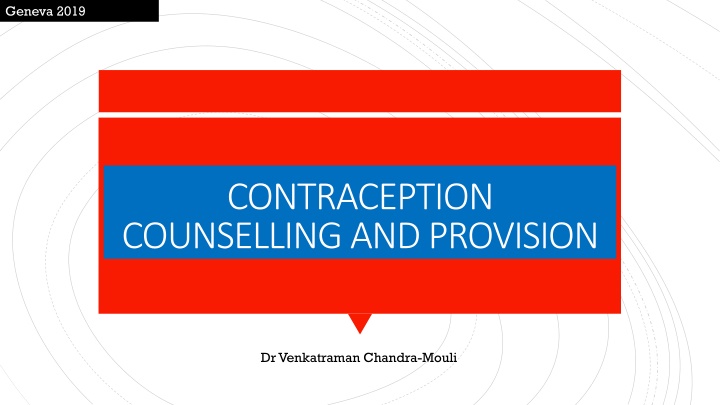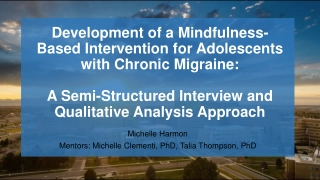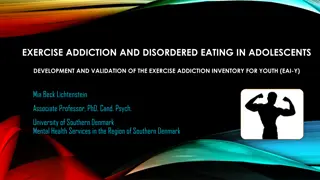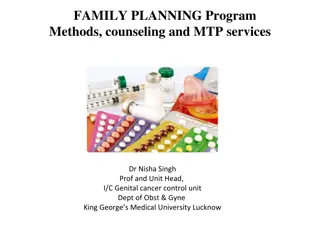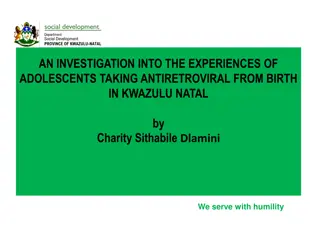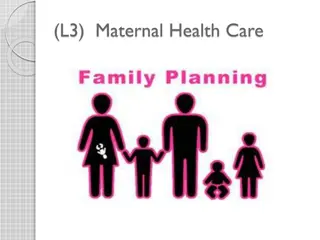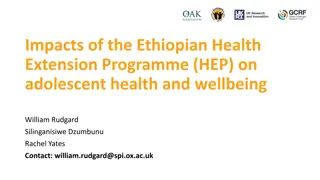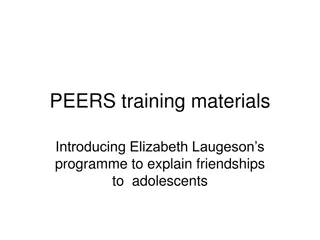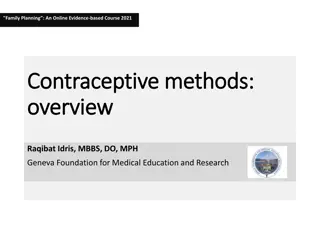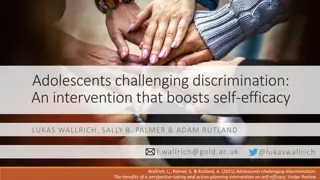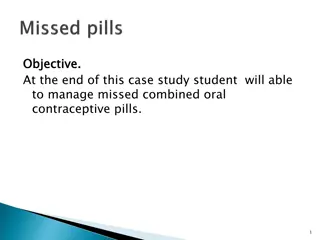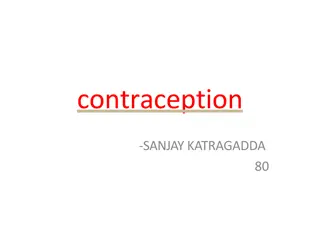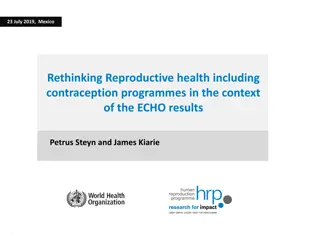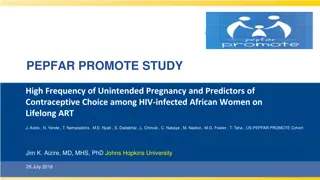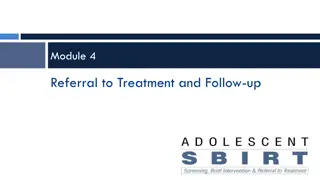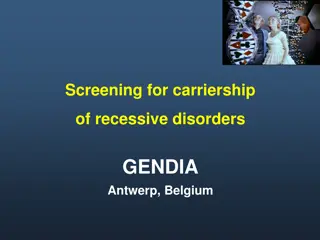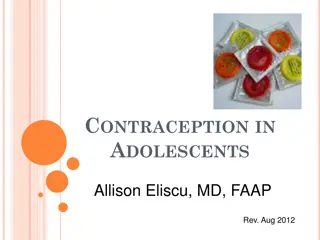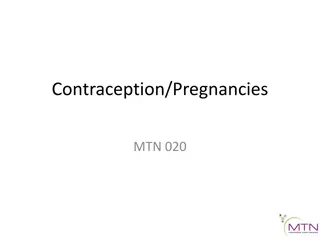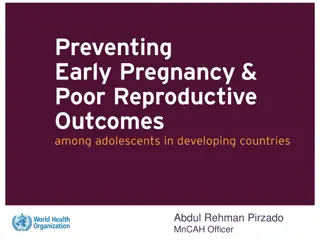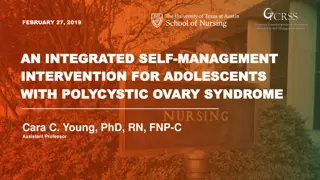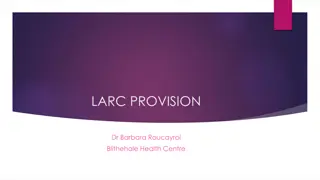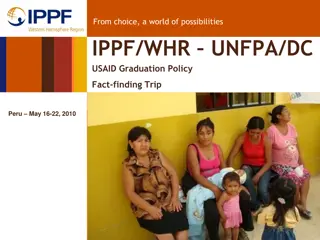Addressing Early Pregnancies Among Adolescents Through Contraceptive Education
Contraception plays a critical role in preventing early pregnancies among adolescents, reducing maternal and newborn mortality, and promoting overall well-being. Effective promotion of contraceptive use hinges on knowledge, access to services, and removing barriers. States are mandated to uphold human rights laws by providing adolescents with confidential, affordable, and non-discriminatory contraceptive information and services. Success in combating early pregnancies requires a comprehensive approach that prioritizes education, access, and rights-based policies.
Download Presentation

Please find below an Image/Link to download the presentation.
The content on the website is provided AS IS for your information and personal use only. It may not be sold, licensed, or shared on other websites without obtaining consent from the author.If you encounter any issues during the download, it is possible that the publisher has removed the file from their server.
You are allowed to download the files provided on this website for personal or commercial use, subject to the condition that they are used lawfully. All files are the property of their respective owners.
The content on the website is provided AS IS for your information and personal use only. It may not be sold, licensed, or shared on other websites without obtaining consent from the author.
E N D
Presentation Transcript
Geneva 2019 CONTRACEPTION COUNSELLING AND PROVISION Dr Venkatraman Chandra-Mouli
Contraception is the intentional prevention of pregnancy by artificial or natural means. It enables people to attain their desired number of children, & to determine the spacing of their pregnancies by delaying or preventing child bearing. Contraceptive methods are designated by duration & context of use (permanent, long acting, short-term or emergency) & by mode of operation (hormonal, non- hormonal, barrier or fertility awareness- based). DEFINITION
Early pregnancies, both intended or unintended, among adolescents are an important problem: In 2016, an estimated 21 million girls aged 15-19 in developing countries became pregnant, approximately 12 million of whom gave birth. An estimated 2.5 million girls aged under 16 years in low-resource countries give birth every year. Early pregnancies among adolescents have major health and social consequences: Pregnancy & childbirth complications are the leading cause of deaths among girls aged 15-19 years globally. Girls aged 10-19 face higher risks of eclampsia, puerperal endometritis and systemic infections than women aged 20-24. 3.9 million unsafe abortions occur each year among girls aged 15-19. Babies born to mothers under 20 years of age face higher risks of low birth weight, preterm delivery and severe neonatal conditions. RATIONALE 1/2
Promotion of contraceptive use to address early pregnancies among adolescents has been shown to be effective: When correctly & consistently used, contraceptives can prevent unintended pregnancies & thereby reduce maternal & newborn mortality & morbidity. Male & female condoms can protect again both unintended pregnancies & HIV/STI. RATIONALE 2/2 Laws & policies, & the provision of good-quality services need attention: Contraceptive use in sexually active adolescents is lower than in other age groups because of lack of knowledge gaps and misconceptions, difficulties in being able to obtain contraceptive services/commodities, & difficulties in wanting to/being able to use them correctly & consistently.
States are obliged under human rights law to provide contraceptive information & services to adolescents, & to adopt legal & policy measure to ensure their access to affordable, safe and effective contraceptives. Contraceptive information & services should be free, confidential, adolescent-responsive and non-discriminatory; barriers such as third party authorization requirements should be removed. Adolescents should have easy access to the full range of contraceptive; such access must not hampered by marital status or providers conscientious objections. HUMAN RIGHTS OBLIGATIONS
Laws & policies prevent the provision of contraception based on age or marital status, in many countries: Critical to adolescent- friendly service provision are laws & policies that support their access to contraception regardless of age or marital status, & without third-party authorization/notification. KEY CONCEPTS TO CONSIDER - 1/2 Many adolescents have misconceptions about contraception or do not know where & how to obtain contraceptive information & services: CSE is an effective way to reach & inform adolescents about contraception. It should be complemented by reaching out to parents, teachers & other gatekeepers.
Contraceptive services & health-care providers are often not adolescent friendly: There is a need to overcome health-care provider biases and misconceptions regarding contraceptive use by adolescents. KEY CONCEPTS TO CONSIDER 2/2 The contraceptive needs of adolescents are diverse & evolving: Complementary strategies must be used to respond to the differing needs & preferences of adolescents, Additionally programmes must address the needs of special population of adolescents (e.g. those with disabilities, migrants and refugees).
WHO guidelines on preventing early pregnancy & poor reproductive outcomes among adolescents in developing countries (2011) Ensuring human rights in the provision of contraceptive information & services: guidance & recommendations (2014) Medical eligibility criteria for contraceptive use, 5th edition (2015) Selected practice recommendations for contraceptive use (2016) WHO Responding to children & adolescents who have been sexually abused: WHO clinical guidelines (2017) GUIDELINES Consolidated guideline on sexual & reproductive health & rights of women living with HIV (2017) Guidance statement: hormonal contraceptive eligibility for women at high risk of HIV (2017) WHO recommendations on health promotion interventions for maternal & newborn health (2015) Responding to intimate partner violence & sexual violence against women: WHO clinical and policy guidelines (2013)
Medical eligibility criteria wheel for contraceptive use (WHO, 2015) Family planning: a global handbook for providers (2018 edition) (WHO, 2018) Compendium of WHO recommendations for postpartum family planning (WHO, 2016) Training resource package for family planning (WHO: https://www.fptraining.org/) Reducing early and unintended pregnancies among adolescents: evidence brief (WHO, 2017) COMPLEMENTARY GUIDELINES TO WHO s GUIDELINES Task sharing to improve access to family planning/contraception: summary brief (WHO, 2017) Adolescents and family planning: what the evidence shows (ICRW, 2014) High-impact Practices (HIPS) in family planning: adolescent-friendly contraceptive services- mainstreaming adolescent-friendly elements into existing contraceptive services (USAID, 2015) Youth contraceptive use: effective interventions- a reference guide (PRB, 2017) Global consensus statement for expanding contraceptive choice for adolescents and youth to include long-acting reversible contraception (FP 2020, 2017).
